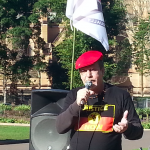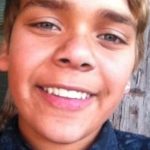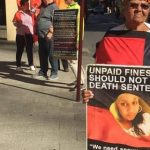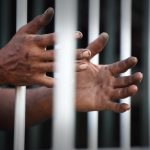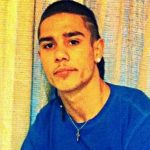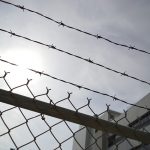Waterloo Injustices: An Interview with Indigenous Social Justice Association’s Ken Canning
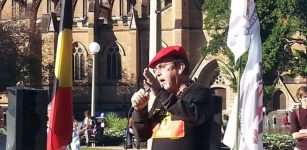
A 31-year-old Aboriginal man fell from the 13th floor of an apartment block in Sydney’s Waterloo on February 7. The man slipped from the balcony of the residence, as he was trying to evade Redfern police officers who were attempting to gain access to the apartment.
Father-of-three, Patrick Fisher was at his girlfriend’s place, when officers began knocking at the door. The local police had been trying to track the Wakka Wakka man down over two outstanding warrants for assault and stealing offences.
This tragedy has led some to comment that while this happened to a young Aboriginal man being pursued by police officers, you don’t often hear about non-Indigenous people losing their lives whilst fleeing police.
More than 100 people assembled in Redfern last Sunday to hold a smoking ceremony, and march through the streets calling for justice. Those gathered were well aware that 14 years ago, almost to the day, a very similar incident took place just a few hundred metres from where Mr Fisher fell.
Remembering TJ
On February 14 2004, 17-year-old TJ Hickey was riding his bike through the streets of Waterloo, when a NSW police paddy wagon being driven by senior constable Michael Hollingsworth began following the boy down a pathway.
Moments later, the young Gamilaraay man was thrown off his bike and impaled on a fence. Locals allege a police vehicle hit the back of the boy’s bike, which caused him to be flung into the air, while police allege his bike collided with the curb.
TJ died the following day in hospital, due to the severity of his wounds. And that night a group of locals took to the Redfern streets in protest, with a full-scale riot breaking out.
During the coronial inquiry constable Hollingsworth was excused from giving evidence on the grounds that he might have incriminated himself. And NSW police continues to claim that its officers were not responsible for the young man’s death.
Deaths in custody
Since December 2015, four Aboriginal deaths in custody have occurred in NSW. On the 29th of that month, David Dungay died whilst being restrained by corrective officers at Long Bay gaol. The 26-year-old Dunghutti man was injected with a strong sedative just before he stopped breathing.
Rebecca Maher was placed in a holding cell at around 1 am on July 19 2016. There are conflicting stories as to why she was detained, but the 36-year-old Wiradjuri woman wasn’t officially arrested. Officers found Ms Maher dead in her cell five hours later.
Eric Whittaker, a 35-year-old Gamilaraay man, died in July last year shackled to a hospital bed, after being removed from prison with head injuries. And Tane Chatfield, a 22-year-old Wakka Wakka and Gomeroi man, was found unconscious in a Tamworth prison cell last September.
A Murri activist
Ken Canning has been a vocal critic of the racist systems and institutions that continue to allow these tragic injustices to take place. Sydney Criminal Lawyers® spoke with Mr Canning, media spokesperson for the Indigenous Social Justice Association, about the need for greater police accountability.
Firstly, Ken, Patrick Fisher fell from a 13th floor apartment in Waterloo, as police were trying to gain entry. In your understanding, what actually happened last week?
The police were there to make an arrest for minor charges. The young man, Patrick, tried to escape by going from balcony to balcony. And he slipped and fell.
The question that remains is: why didn’t they wait for him to come out at the ground floor? They could have stopped the car there and waited. If you start pushing doors in at such a height, young people tend to want to escape.
The other thing is that it’s well-known amongst the Aboriginal community that Patrick had been the recipient of violent actions by Redfern police in the past. So, he would have been in fear of his safety. It was a fight or flight sort of thing. They’re aware of this.
You see on the news that a much more dangerous person will be put under surveillance. They’ll wait for them to come out and grab them. Those times when somebody is deemed to be much more violent, they wait for them to come out.
Why couldn’t they do this with Patrick? Why did they have to go up to the 13th floor and start hammering on the door, frightening the daylights out of a man that had already been the victim of violence from the police?
People have commented that you don’t hear about non-Aboriginal people losing their lives whilst fleeing police. What do you think about that observation?
There’s a couple of points. Our community is terrorised much more frequently by police. They are under threat by police. And it is well-known by our people – and everybody else – that we have the highest rates of deaths in custody per population in the world.
So, when the police come, we don’t react like some other people might, or go quietly like others might. We will try and escape because it’s been said for many years, “Don’t go to gaol. It could be a death sentence.”
In the recent years, there’s been a 25 percent increase in the incarceration of Aboriginal people. And in the last 18 months, there’s been several highly suspicious deaths in custody.
So, our young people are getting very cautious about being in the presence of police, or any authorities for that matter. They see being locked up as a possible death sentence. You can’t afford to go in. It’s not an option for young people, as they’re feeling in fear of their lives.
Until the NSW police change their attitude towards Aboriginal people, this is going to go on. Not every NSW policeman is guilty of assault, but those who are doing it, are getting away with impunity because of their fellow officers.
I’m sure there’s a lot of policeman out there who witness assault. But, until they have the moral fortitude and the courage to arrest and charge those people with assault, this is going to go on and on. And it will not stop.
The ball is back in the court of the NSW police force, and all Australian police forces. Stop the thugs in uniform. It’s as simple as that.
Following the incident, NSW police announced that it would be undertaking a critical incident investigation into Mr Fisher’s death. What do you expect to come from an internal investigation like this?
Nothing. As per usual, the Botany police are going to investigate the Redfern police. It’s like I trash my own place and I stick my head out to my mate who lives next door and say, “Just tell everybody I was out. And say some unknown strangers did it.”
That’s how investigations like that go. It’s mate on mate. There’s no independence whatsoever. I have no faith in their inquiries. Their inquiries have never given any answers before.
We had a coronial inquiry 14 years ago into the killing of TJ Hickey. And the police just covered up for each other. The most common answer at the witness box at the coronial inquiry was, “I cannot recall.”
If that is how an inquiry is held – that people cannot recall – you can’t have faith in that sort of system. It’s ridiculous. They’ve got good memories when they want to convict somebody. But, it appears when something tragic happens, they lose their memory.
Last Sunday, locals marched through the streets in Redfern calling for justice over the death of Mr Fisher. What would you say the general sentiments were of those gathered?
A lot of anger and a lot of frustration. Again, something has gone wrong with the procedural process between police and Aboriginal people.
Whichever way the police want to paint it, they’ve got to look at their own history, and their own methodologies in policing Aboriginal people. And they’ve got to look at the whole history of deaths in custody, and violence against Aboriginal people.
I work in a halfway house for people coming out of gaol. Every last one of them state that when they get arrested it’s mandatory for them to get a bashing. The police can deny that all they like. But, not every Aboriginal person that is arrested is telling lies.
I recently had a policeman say to me that in 17 years of policing he’s never witnessed an assault. Now, I would say that’s absurd.
This week marks 14 years since TJ Hickey died, after being pursued by police. How can we account for two tragic deaths like these happening 14 years apart, under such similar circumstances?
Very similar circumstances. And it’s indicative of NSW police heavy-handedness. There’s always trouble from the NSW police force in one form or another around the date of the TJ Hickey march. They are either trying to take us to court or trying to set up the family.
I’m highly suspicious this was just another case of Redfern police flexing their muscles to show that they are in control.
Until they can show different by their actions – and again the ball is in their court – that’s what Aboriginal people will believe: this is them trying to macho their way out of a problem that was caused by them anyway.
The TJ Hickey death is right at their feet. The inquiry was totally corrupt. They know it. Everybody knows it. David Shoebridge has called for a parliamentary inquiry into that incident. But, he doubts that the Liberal or Labor party will go for it. So, we probably won’t get to that point.
But, that again begs the question: what have they got to hide? A parliamentary inquiry can only bring us closer to the truth of what happened to TJ. So, if all these political powers are trying to hide it, they’re protecting the very police force that are terrorising Aboriginal communities.
Since December 2015, there have been four Aboriginal deaths in custody in NSW. In your opinion, can we see a correlation between these deaths and those of TJ and Patrick?
All the deaths have the same element to it, which is the overuse of force, or the abuse of power if you look at Rebecca Maher.
But also, the other element that they all have is, with every single death the police or prison officers will give conflicting statements.
It was first said that Rebecca Maher was drunk and disorderly. Bad luck on that one. There was no drugs or alcohol in her system. It was said that she was reacting irrationally and reported by a member of the public. But, the police could not name who the member of the public was.
It was said the custody notification service was not enacted, because they didn’t know she was Aboriginal. The Aboriginal Legal Service were informed she was Aboriginal by the Maitland police a few years before.
So, she was taken into custody for no reason whatsoever. And she died. They had all these different versions of what happened.
In 2015, David Dungay died. There’s several different versions of what happened by the police. And the CCTV footage has completely disappeared.
There were also three different versions of what happened to cause Eric Whittaker’s head injuries. There were several different versions of Tane Chatfield’s death. It’s gotten to the point now that if an inmate mentions his name up at Tamworth, they’re in trouble.
And also, we get ministers of the Crown coming out within an hour of any of these deaths and stating that there are no suspicious circumstances. How on earth do they know this when there’s been no inquiry?
And this shows you that from the word go, the ministers responsible are the ones who are embarking on a path of coverups by making these statements.
When David Dungay died it wasn’t even an hour and the minister had said there’s no suspicious circumstances. How would he know? He wouldn’t have had time to get out of bed and go out to the gaol?
So, unless he’s clairvoyant, the man is absolutely corrupting an inquiry by informing the public initially that there are no suspicious circumstances. That’s what’s reported. And that is a travesty of justice.
And lastly, Ken, on a broader scale how would you describe the long-term relationship that police forces across the country have with Aboriginal and Torres Strait Islander people?
Well, it’s deteriorating. If you look historically, it was never that good.
If you look here in the Glebe area, where I live, there was a time that the stop and search procedures were over 11 percent for Aboriginal people. But, we are very much under 1 percent of the population in this area.
It was the community that got it cut. But, it is still very high in regard to our population in this area. And that’s all over the country. Adult people nationally make up close to 30 percent of the prison population. And we only make up 2.8 percent of the population.
If you look in the Northern Territory since the Intervention, 84 percent of adults incarcerated are Aboriginal and Torres Strait Islander people. While 94 percent of incarcerated juveniles are Aboriginal and Torres Strait Islander people.
These are figures that should set off international alarms at the UN. But, apparently they’re not. We don’t count. And the media puts out misinformation and will not highlight these facts. This is part of the problem as well.
So, the policing is way over the top. We have the information coming to us daily about police brutality and illegal arrests. It’s done on a daily basis. And it’s going to get worse and worse.
Again, the Australian police force is going to have to really review how they police, not just our people, but everybody.
If they see an assault, they should be duty bound to arrest that person. Because the next assault could be the death of somebody. And if they allow that thug to go lose, then they’re complicit in that possible death.
They need to have the fortitude and the backbone to stand up to this wall of silence. And they need to do their job as police officers, which means treating everybody equally in the eyes of the law.
If there are people who are committing assault, they should be arrested and charged, and put before the courts. They should be dealt with as any other person would be. But, at the moment, that’s not happening.
When people who have violence in their blood are in these uniforms, and they are allowed to act with impunity, that’s when deaths happen.


